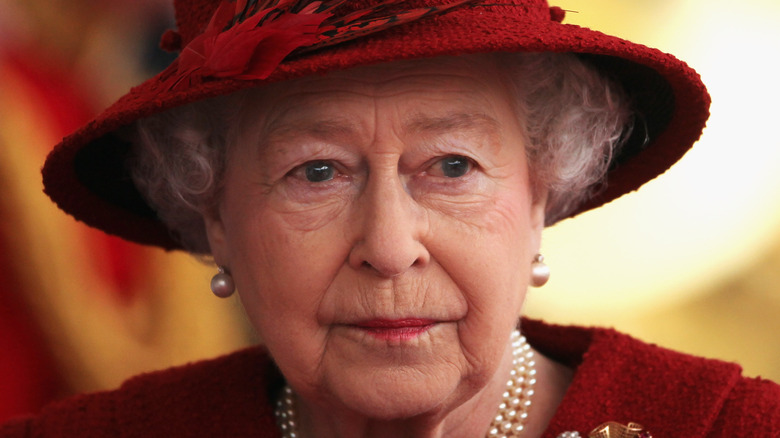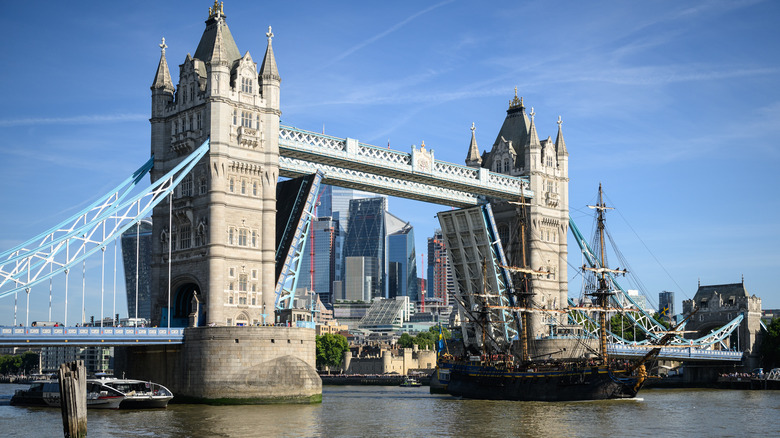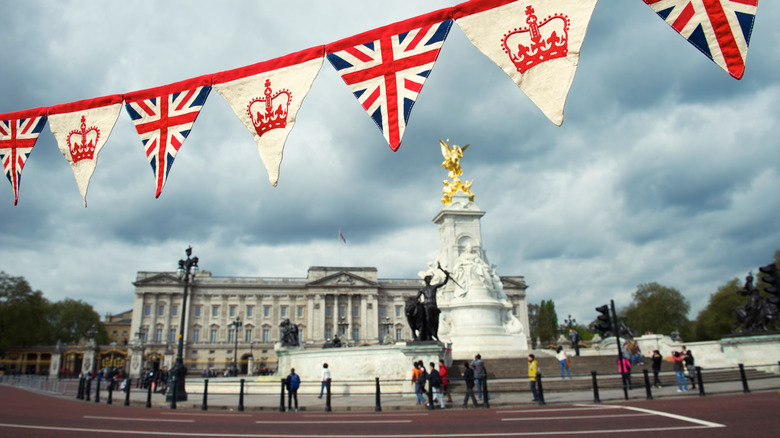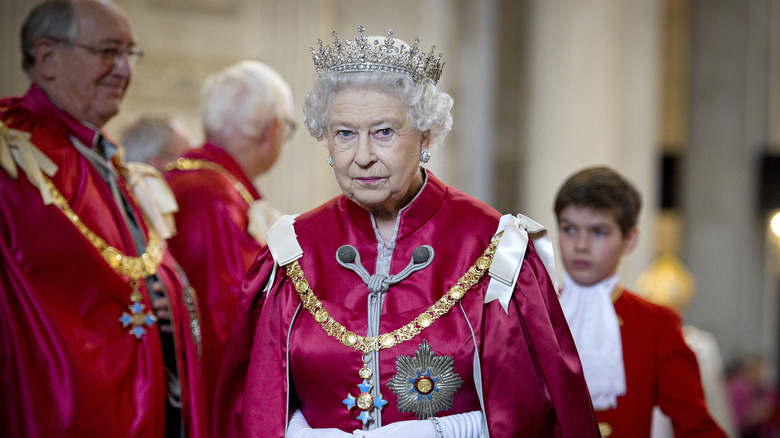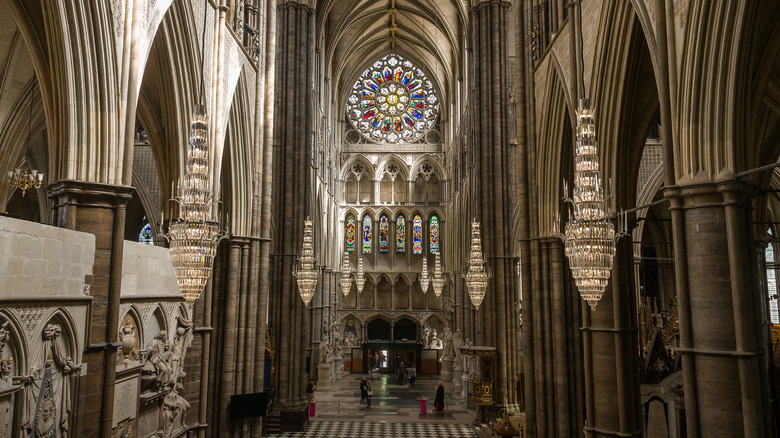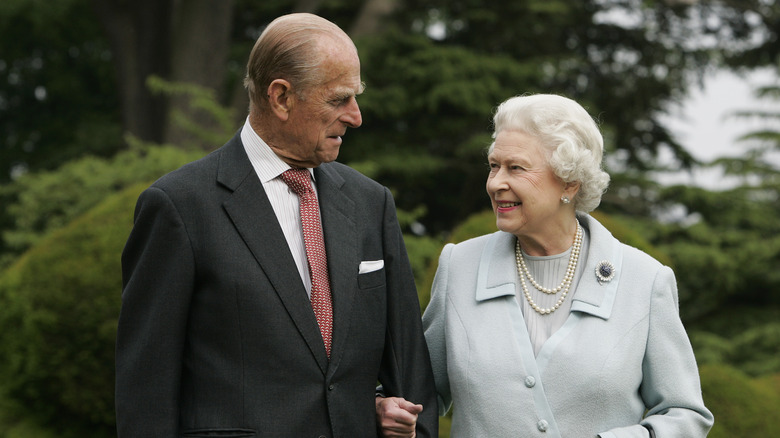The Origin Of Operation London Bridge, The Detailed Plan For Queen Elizabeth II's Death
When a member of the British royal family dies, there is a concerted effort to follow various protocols, many of which have evolved over the centuries. With England's longest-reining queen, Elizabeth II, taking the throne in February 1952, the preparations for Queen Elizabeth II's death and the aftermath have been in place for several decades, according to The Guardian. But in 2022, with the queen having lived 96 years, those involved with ensuring her death is handled according to plan may soon be tested.
Queen Elizabeth II is one of the most beloved royals alive today, according to NPR. In part, it's that she has been a steady and benign public figure for seven decades. She also pledged her life to the public at just 21 years old, according to a Twitter post by the royal family, saying, "I declare before you all that my whole life whether it be long or short shall be devoted to your service."
Having lived up to her promise, agencies from across the spectrum will work together to ensure that she is given the show of respect that the queen herself has approved, according to My Parish Council. The entire affair will kick off upon her death, and its codename is "Operation London Bridge."
The reason for codenames
The idea of giving the deaths of monarchs a codename is not new. According to the Independent, in the days when Buckingham Palace had switchboard operators, codenames for deaths in the royal family were used so the workers would not learn of the death and leak the information before an official announcement could be made to the public. Per Birmingham Live, King George VI's death was codenamed "Hyde Park Corner" when he died in 1952 at 56 years old, leading to Elizabeth's eventual coronation.
Other death codenames included the same one for the Queen Mother and Princess Diana — "Tay Bridge." The Independent reported they shared a codename because Diana's death at 36 was sudden and unexpected so the plans that had been in place for the Queen Mother — who lived to 101 — were used for Diana. When Prince Philip died, it was codename "Operation Forth Bridge," and the planned codename for Prince Charles is "Operation Menai Bridge."
Even Winston Churchill was given a codename in 1953 for his eventual death in 1965. "Operation Hope Not" was established to honor the prime minister with a grand death procession for his service in guiding the nation through World War II, per Birmingham Live.
Several agencies will work together
The codename for Queen Elizabeth II's death came about in the 1960s, according to The Guardian. Since then various agencies have met a few times a year to hash out the plans. Over the decades and the changing of the times, some ideas have been quashed, while others have been implemented. Though the queen has approved much of it, some of the items can only be decided after the fact by Prince Charles, assuming he is the one who will become king upon her death, per My Parish Council.
Those who meet up to discuss and plan for the queen's death include members of the Church of England, The British Armed Forces, the Metropolitan Police Service, Transport For London, journalists, London Boroughs, the Royal Parks, government departments, and The Greater London Authority. One of those representatives told The Guardian, "Everyone around the world is looking to us to do this again perfectly, and we will."
London Bridge is Down
When Queen Elizabeth II dies, the public won't find out immediately, but the words first spoken of the death will be "London Bridge is down," according to The Guardian. First, Politico describes a "call cascade" will start in which the prime minister and other high-ranking officials will be informed. The queen's own secretary will tell the PM and the Privy Council Office, which is a governmental agency that represents the monarchy, per Politico. Soon after, her death will be announced to both the Press Association and the media outlets worldwide all at the exact same time, according to The Guardian. A Buckingham Palace footman in mourning clothes will pin a "black-edged notice" to the gates of the queen's palatial home.
An alert will also sound at the BBC that many have never heard before, as it's an alarm called the "radio alert transmission system" the media company has had in place since the 1930s that is expected to withstand any attack on the nation, including on its infrastructure. In short, the news of the event of her death and getting the word out, along with doing so in a dignified way, will be the first order of business.
Social media will certainly be involved, but even how that is done is already established. For instance, social media pages belonging to governmental agencies are instructed to make their "departmental crest" their profile picture, along with including a black banner. What's more, they are not allowed to retweet nor should they publish content that is not pressing, according to Politico.
National mourning
While it's up to the royal family to announce the date for Queen Elizabeth's funeral, the prime minister is slated to be the first government agent to make a public statement. No one else in a government role can do so until after the PM, per Politico. On the day of her death, there will be a national moment of silence for one minute and "gun salutes" from various military stations.
Finally, around 6 p.m. of the day of the announcement, assuming the timing works out, the public will hear from Prince Charles, who will soon after become king. The queen's funeral is likely to be held about 10 days after her death at Westminster Abbey, and during those 10 days there will be ongoing events to honor the late monarch, whom many have called queen their entire lives. Though her death is expected and is the natural order of things, it's still a death that will be difficult for many to adjust to.
Penny Juror, a royal biographer told Town & Country, "The Queen is such a tremendously popular figure and during the course of her reign, so much has changed so dramatically. There's not an aspect of life that hasn't changed, but the one constant in the midst of this has been the Queen, the rock solid thing we can hang on to."
Elizabeth ii will be laid to rest with her late husband
Once the queen dies and the news is spread around the world, her body will stay at Buckingham Palace for a few days before being moved to Westminister Hall where she will lie in state. The public will be able to go to her casket at that time ahead of her funeral, according to British Heritage.
Her funeral is expected to draw high-ranking officials from all over the globe. The day of the service will be a national day of mourning with Big Ben chiming at 9 a.m and the crown jewels being cleaned before the queen's body arrives at the church around 11 a.m. An archbishop will conduct the service, per The Guardian, and during that time the media is banned from showing the faces of any of the royal family.
In keeping with tradition, the queen's casket is to be moved on the same gun carriage that her father, grandfather, and great-grandfather were placed on as 138 junior sailors in the Royal Navy physically pull the carriage and the late queen along the next phase of the procession. Finally, Queen Elizabeth II will be buried in King George VI Memorial Chapel at Windsor Castle, per Politico. According to Insider, Prince Philip's casket will be moved from the Royal Vault under St. George's Chapel at Windsor Castle to join his wife of 73 years in burial.
